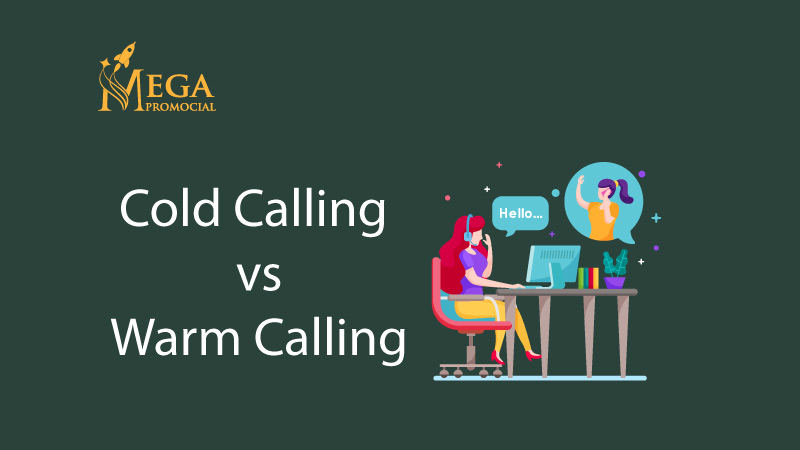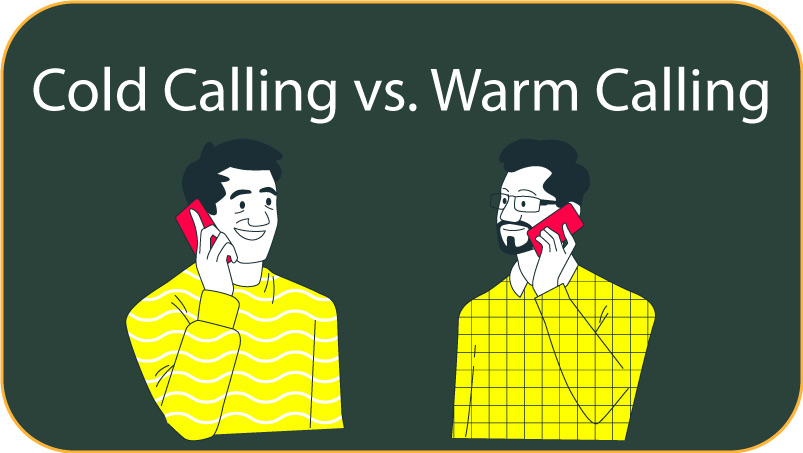Navigating the Future: Key Industry Trends Shaping Digital Marketing
In the fast-paced world of digital marketing, staying ahead of the curve is essential for businesses and marketer

Introduction
In the dynamic realm of sales, effective communication is pivotal for success. Cold calling and warm calling stand out as two prominent techniques, each uniquely contributing to the customer engagement process. Cold calling involves reaching out to prospects without prior contact, demanding adeptness in swiftly establishing rapport. Despite its challenging nature, mastering cold calling involves refining persuasive language and objection-handling skills.

Conversely, warm calling leverages pre-existing connections or leads, capitalizing on established relationships to foster a more receptive atmosphere. This technique relies on strategic timing and personalized approaches, emphasizing the importance of maintaining a warm prospect relationship.
Navigating the intricacies of these methods demands a tailored approach. For cold calling, meticulous research on the target audience is crucial, enabling the customization of pitches to resonate with potential clients. In warm calling, understanding the existing relationship dynamics aids in crafting compelling narratives that resonate with the prospect’s needs. The art of communication in sales encompasses both cold and warm calling, each requiring a nuanced strategy. Successful sales professionals adeptly blend these approaches, tailoring their communication styles to forge meaningful connections and drive business growth.
Defining Cold Calling and its Features
Cold calling is a proactive sales technique where sales professionals initiate contact with potential customers, lacking any prior relationship. This method involves making unsolicited phone calls to individuals or businesses with the aim of introducing a product or service, generating leads, and ultimately closing deals.
One defining feature of cold calling is the absence of prior knowledge or a pre-existing relationship with the prospect. Salespersons typically possess limited information about the potential customer, making it crucial to capture their interest and attention within the initial moments of the call. Due to its nature, cold calling often requires a higher volume of calls, given the relatively lower success rate.
Successful cold calling demands meticulous preparation and confidence, as salespeople may encounter rejection or disinterest from prospects. Exceptional communication and persuasion skills are essential to engage the prospect, address their pain points, and effectively present the value proposition.
Handling objections and overcoming skepticism are integral aspects of cold calling. Since the prospect has not expressed any prior interest or need, the salesperson must swiftly build trust and credibility. This involves understanding the prospect’s needs, demonstrating industry knowledge, and providing tailored solutions.
Cold calling is a proactive approach that requires persistence, resilience, and adaptability. While it poses challenges and the potential for rejection, strategic and professional execution can lead to valuable connections, new opportunities, and successful sales conversions.
In contrast to cold calling, warm calling leverages pre-existing connections or leads, creating a more receptive atmosphere. The warmth of an existing relationship allows for a more personalized approach and increased likelihood of engagement. Sales professionals employing warm calling strategies benefit from established rapport, enabling them to navigate conversations with a foundation of trust, ultimately enhancing the chances of successful outcomes. Both cold and warm calling play integral roles in the dynamic landscape of sales, necessitating distinct yet complementary skill sets for optimal effectiveness in customer engagement and business growth.
Advantages of Cold Calling
Challenges of Cold Calling
In summary, cold calling, despite its challenges, offers advantages in broad audience outreach, valuable market feedback, and skill development through resilience. Its potential for reaching diverse audiences and refining strategies makes it a valuable tool for sales professionals committed to overcoming rejection and honing communication skills over time.
Understanding Warm Calling and its Characteristics
Pros and Cons of Warm Calling
Pros encompass broad outreach, feedback gathering, and skill development for cold calling. Warm calling excels with established connections, ensuring a more receptive, successful approach.
Cons for cold calling include high rejection potential and demanding time and effort. Warm calling, while effective, may lack the expansive reach associated with cold calling. Both strategies have their limitations.
Choosing Between Cold Calling and Warm Calling
The strategic choice between cold calling and warm calling hinges on factors such as the target audience, sales goals, and available resources. Cold calling, with its broad outreach, may suit expanding customer bases, while warm calling, leveraging established connections, proves effective for personalized approaches. Tailoring the method to the specific context ensures optimal results, reflecting the dynamic and adaptable nature of successful sales strategies. Consider the following:
In making the choice between cold calling and warm calling, consider your circumstances carefully. A strategic approach, aligned with your specific objectives, is crucial for success. Cold calling may suit quick results and broad outreach, while warm calling is effective for personalized, relationship-based engagement. Assessing your goals, timelines, and available resources ensures the optimal integration of both cold and warm calling techniques, enhancing your ability to navigate the dynamic landscape of sales successfully.
Mastering the Art of Both Cold and Warm Calling
Sales success demands proficiency in both cold and warm calling. Cold calling, with its broad outreach and skill development through rejection resilience, is crucial for expanding the customer base. On the other hand, warm calling leverages established connections, offering a more personalized and receptive approach. A well-rounded sales professional adept in both strategies navigates the dynamic landscape effectively, combining outreach efficiency with relationship-based engagement to achieve comprehensive and sustained success in diverse sales scenarios. Key strategies for mastery include:
By integrating these strategies, sales professionals can enhance success rates and achieve their sales goals effectively. Thorough research, whether for cold or warm calling, ensures a tailored and informed approach. Paying close attention to prospect responses, actively addressing concerns, and emphasizing product value in meaningful conversations enhances engagement and trust.
Viewing rejections as opportunities for learning, staying flexible, and adapting strategies based on feedback fosters resilience. Strategically assessing goals, timelines, and available resources enables a balanced utilization of both cold and warm calling techniques.
Ultimately, a strategic and informed blend of these approaches aligns with the dynamic needs of the sales landscape. This integration optimizes engagement, maximizes lead conversion, and cultivates valuable connections, propelling sales professionals towards consistent success in achieving their objectives.
Tips for Effective Call Scripting
Well-crafted call scripts play an indispensable role in the success of both cold and warm calling efforts. In cold calling, a script helps swiftly capture interest, navigate objections, and communicate value. For warm calling, a script ensures a consistent and personalized approach, leveraging prior interactions. Crafting scripts tailored to each scenario equips sales professionals with the communication tools necessary to engage effectively, whether initiating contact or building upon existing connections, ultimately contributing to successful outcomes in the dynamic realm of sales. Follow these tips for creating effective scripts:
Remember, scripts are guides, not strict rules. Adapt based on prospect cues while maintaining the intended structure.
Optimizing Your Call List
Efficiency and success in both cold and warm calling hinge on optimizing your call list. Tailoring the list to target audiences, preferences, and prior interactions enhances engagement, ensuring that each call is strategic and increases the likelihood of successful outcomes in the dynamic landscape of sales. Strategies include:
By optimizing your call list, you focus efforts on promising prospects, enhancing your chances of success in both calling approaches.
Boosting Conversion Rates with Follow-Up Techniques
Increasing conversion rates in both cold and warm calling demands strategic follow-up techniques. Persistent and well-timed follow-ups in cold calling show commitment and reinforce value propositions. In warm calling, a personalized approach using prior interactions for tailored follow-ups deepens relationships. Balancing frequency and relevance is key, ensuring prospects feel valued. Integrating effective follow-up strategies allows sales professionals to maximize chances of converting leads into valuable connections, irrespective of the initial contact method.
Effective follow-up is a critical component in both cold and warm calling strategies. It demands organizational prowess, timely actions, and thoughtful engagement to nurture relationships and enhance conversion potential. Whether initiated through cold calls or built upon warm leads, systematic and well-timed follow-ups demonstrate commitment and reinforce value propositions. This strategic approach ensures prospects feel valued, contributing to increased engagement and trust. By integrating effective follow-up techniques, sales professionals maximize their chances of converting leads into valuable connections, regardless of the initial contact method.
Maximizing Your Sales Potential

Maximizing sales potential is the primary goal for sales professionals, irrespective of whether they employ cold calling or warm calling techniques. Organizational efficiency is critical, and leveraging a Customer Relationship Management (CRM) system becomes paramount. This tool aids in tracking prospect details, preferences, and pain points, enabling a tailored approach that significantly enhances the likelihood of success. By efficiently managing information, sales professionals can engage with prospects more effectively, increasing their chances of lead generation and successful deal closure.
Continuously refining your sales pitch and approach is a critical aspect of achieving maximum sales potential. Through the analysis of calls, soliciting feedback, and engaging in role-playing exercises to practice different techniques, sales professionals can enhance their communication and persuasion skills. Persistence is a powerful tool in the sales arsenal—consistently following up with prospects across various channels demonstrates commitment and provides additional value, thereby increasing the likelihood of converting leads into valuable connections.
In the competitive landscape of sales, continuous education is pivotal for staying ahead. Sales professionals must stay informed about evolving industry trends, competitor offerings, and the intricacies of their own product or service. This commitment to enhanced knowledge not only boosts confidence but also significantly contributes to increased effectiveness in sales conversations. Being well-versed in the latest developments allows sales professionals to engage with prospects on a deeper level, providing valuable insights and positioning themselves as trusted advisors. In an ever-evolving market, a dedication to continuous learning becomes a strategic advantage, ensuring adaptability and success in navigating the dynamic challenges of the sales landscape.
Implementing these strategies—organization, continuous refinement, persistence, and ongoing education—serves to maximize your sales potential. Whether deploying cold or warm calling methods, these actions significantly elevate the chances of lead generation and successful deal closure. Success in sales is indeed a journey, and with the right mindset and consistent effort, achieving your sales goals becomes not only possible but probable.
In conclusion, the synergy of integrating both cold and warm calling, supported by effective strategies, empowers sales professionals to navigate the dynamic sales landscape successfully. Cold calling proves instrumental in expanding the customer base, leveraging its wide reach and skill development aspects. Conversely, warm calling excels in relationship nurturing, capitalizing on pre-existing connections and a more personalized approach. The art of communication in sales demands tailored strategies for meaningful connections and sustained business growth. By embracing both techniques strategically, sales professionals can adapt to diverse scenarios, optimize customer engagement, and drive comprehensive success. It underscores the importance of a versatile skill set, acknowledging the unique advantages each method offers, and emphasizing the need for adaptability to achieve consistent and sustainable business growth in the competitive sales environment.
Our blog is a hub for valuable resources, informative guides, and insightful commentary on a
variety of industry topics, designed to help you stay up-to-date and informed.
In the fast-paced world of digital marketing, staying ahead of the curve is essential for businesses and marketer
In the fast-paced and ever-evolving world of digital marketing, staying informed and continuously learning is cru
In the ever-evolving world of digital marketing, staying ahead of the curve and building a strong online presence